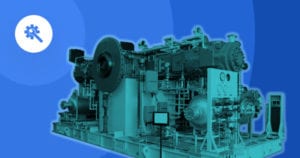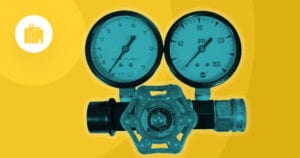
Until the first half of the 20th century, industrial organizations relied primarily on the human factor to control and monitor their processes. However, with increasingly complex operations and ever-larger factories, in the 1970s, digital PLCs (programmable logic controllers) and computers became famous as an interface for data transmission to remote control centers. Soon later, the «telemetry» was born, from the Greek «metria» (measurement) and «tele» (remote), and with it, a control system the SCADA: Supervisory Control and Data Acquisition Systems. It is called the third industrial revolution, and today, there is no industrial company that does not have PLCs or SCADAs in its operation.
Internet of Things (IoT) and Artificial Intelligence (AI) allow today to witness another great technological leap that many dare to call the fourth industrial revolution.
The scope goes far beyond «data acquisition and monitoring.» It focuses on the advanced processing of large volumes of data that allows faster and more efficient decision-making processes and less risk and margin for error. However, we are still in the process of consolidating this new revolution, as the limits between the investment made in the third industrial revolution and the one needed for the fourth one are not yet clear.
In this article, we give three keys to the roadmap that must be followed by any company that doesn’t want to be left out of the fourth industrial revolution.
The IoT Platform As A Complement to SCADA
First, the elephant in the room: SCADAs are not ready for advanced processing of large amounts of data. In the same way that IoT platforms are not prepared for centralized real-time process monitoring and automation. Therefore, there are two types of technologies that are forced to coexist.
The centralized control process of a SCADA can only be realized using databases that ensure reliability and fast response to queries. Generally, centralized databases, structured query languages (SQL), and the financial cost are linked to the «number of variables.» However, these architectures are too rigid for the processing of large volumes of distributed and changing data.
In this sense, IoT Platforms rely on distributed databases, with unstructured languages (NoSQL) and cost per «used resources» (CPU, Memory). IoT platforms are the best suited for creating mathematical models that require advanced AI queries, but there are not optimal for highly reliable real-time processing.
When we look at visualization and user interface functionalities, the goal of a SCADA platform is to model complete processes in a way that makes it simple and easy for an operator to control the process without errors. So, HMI (Human Machine Interface) graphics generation frameworks are optimal.
A dashboard web-like visualization framework is more suitable in the case of an IoT Platform, whose objective is to illustrate loads of historical data, cross-references, or future trends. It seems highly unlikely that shortly there will be one platform that can combine the reliability and speed of a traditional SCADA with the flexibility and scalability of an IoT Platform. Both systems will have to coexist and integrate, for which the correct budget allocation and the coordination of OT and IT departments are critical.
IoT Edge Nodes As A Complement To PLCs
Similarly to what happens in the «control rooms,» near the assets «in the field,» there are also systems that must complement the existing ones. Automated controllers or PLCs are devices whose primary function is to digitize and automate the production process, and their real-time requirements are even more restrictive than in a SCADA. A millisecond error can mean that a robotic arm can fail or that an electrical substation does not coordinate the relays properly, and there is a major global system failure. A PLC aims to focus on its function, and it would not be good to be programmed to perform actions other than those related to the production process.
And so, returning to the previous examples, it does not make sense that the PLC that controls the robotic arm or the relays of the substation is checking other variables that are needed, for instance, making more global decisions such as the environmental conditions of the plant or the presence or not of operators in it. Moreover, to obtain these additional data for AI, it does not make sense to use PLCs since they usually require particular expertise for programming.
Where real-time is not a requirement, but the flexibility to acquire data and treat it in an efficient and scalable way is, the IoT Edge Nodes is the best alternative. These Edge Nodes are mini-computers with high-level languages programming (i.e., Python, C/C++, or able to store Docker containers), and several inputs and outputs as well as combined connection interfaces (e.g., industrial buses with cellular connectivity).
Cybersecurity As A Complement To Safety
Safety refers to the condition of being protected against events that can cause injury. Safety standards, risk management, or disaster response plans are on the daily schedule of any industrial organization, in many cases forced by regulations.
With IoT and AI, we move into the cyber-physical world, where industrial networks (or OT networks) are becoming less isolated and more interconnected. Therefore, they are more vulnerable to both external and internal cyber-attacks that can affect not only the safety of workers but also the continuity of the company’s operations.
In this sense, the traditional risk management and incident response plans and certifications of «Safety» must be complemented by their counterparts in the world of cybersecurity.
The standards that seem likely to become de facto standard in this regard are ISO 27001 for information security management and IEC 62443 for IT security of networks and systems in industrial communications. The introduction and management of elements such as IoT Platforms and Edge Nodes must be done under the umbrella of good practices and standards such as those mentioned above, ensuring the future of this new technology roadmap.
New technologies, such as IoT, AI, or Edge Computing, have not come to replace SCADAs or PLCs but complement them. A correct coexistence and integration of product, human, and processes, between IT and OT, and a vast technological openness, is the response for those industrial organizations that want to jump onto the fourth industrial revolution.





 Related Podcast Episode
Related Podcast Episode




 Related Applications
Related Applications


 Latest IoT News
Latest IoT News










